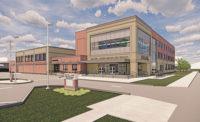Nothing can stop a tornado, but the 2015 International Building Code (IBC) includes changes that may help improve the survivability of schools and other facilities against the destructive, often deadly winds.
The changes in IBC 2015 are themselves the result of recent revisions to the International Code Council’s standard 500, which provides design and construction requirements for “safe rooms” that protect occupants from winds and airborne debris generated by hurricanes and tornadoes.
While ICC 500 has been referenced in previous iterations of IBC, the latest version mandates its use for designated shelters in new educational “Group E” occupancy buildings (e.g., K-12 schools, day-care centers for more than five children) that are located in areas of the country where powerful twisters with winds up to 250 mph are most likely to occur. That includes northern and northwest portions of Texas and the northern half of Louisiana.
Design firms and contractors in both states will find similarities to long-standing shelter requirements in hurricane-prone coastal areas. But there are distinct differences as well.
Because of the relatively short duration of tornado-producing storms, these shelters are designed to house occupants for a short duration until the storm passes. That means capacity area calculations are different than for shelters that might be needed for extended-period storms. And while walls, windows and doors for both types of shelters have requirements for resisting missile-like impacts from windblown projectiles, the envelope of a tornado shelter must stand up to larger, more violently propelled debris.
“The building material would likely be cast-in-place concrete or concrete masonry units,” observes Marty Sims, an associate with Stantec, Plano, Texas. # Despite the short-term nature of ICC 500-compliant tornado shelters, HVAC and MEP systems still must be considered. Toilets and handwash systems have to be independent of city systems, which may call for a stand-alone septic system and water tank.
The shelters also must have proper ventilation and illumination. A natural ventilation system is acceptable as long as its properly sized and all openings to the outside are shielded from wind-borne projectiles. But because natural ventilation may not always be feasible, some kind of emergency power may be needed.
“You have to think about a generator’s location, its accessibility and measures to protect it,” advises Ben Harris, principal director of engineering at Huckabee Architects, Fort Worth.
And once these and many other considerations are accounted for, the design must undergo independent architectural and structural peer reviews. Similarly, an independent structural engineer must be available to perform construction phase inspections.
From Standards to Practice
Familiarity with the IBC 2015 shelter requirements is one thing. But applying them to new projects may well be a more formidable challenge for communities and school districts, particularly when it comes to the added cost of structurally hardening a space against higher wind loads. But by how much?
“That’s the million-dollar question,” Sims says, with a bit of unintentional irony. He adds that while his team’s research into potential costs is ongoing, an IBC 2015-level shelter might well be “a minimum of three times” the cost of conventional construction.
“It’s hard to say because it’s all so new,” adds Kirk Kistner, vice president of Bartlett Cocke, San Antonio. He notes that using thicker tilt-up walls instead of masonry and the limited use of glazing might help reduce costs, “but there will still be trade-offs.”
Sims also notes that while a single designated tornado shelter is feasible for small schools, larger, more expansive facilities such as large high schools may well require multiple shelters. Tornado alerts usually occur on short notice, he explains, and the potential travel distance for students and teachers from the building’s farthest reaches could be an issue.
“There’s no requirement for this yet, but it could happen,” Sims says. “It’s something school districts would have to consider.”
Construction of a tornado shelter as an addition to an existing building is an option, with many Texas school districts having already adopted reinforced concrete domes. But expanding existing school buildings may raise other challenges, as ICC 500’s construction and space requirements apply only to the occupants of an addition.
“Do you size it for everyone in the school or just for the capacity of the new section?” Harris says.
One option that Harris says would likely not prove economically feasible is retrofitting an existing building to ICC 500 standards. “You’re dealing with four times the wind pressure and five times the roof live load,” he says. “That’s a lot.”
Multipurpose Plan
With no choice but to spend more for a code-compliant tornado shelter, a school district’s best option may well be to maximize its investment by ensuring that the space can accommodate as many diverse uses as possible—e.g., a gym, cafeteria or auditorium.
That’s the approach the West Texas Independent School District chose for its new $48-million, 226,000-sq-ft middle/high school. It was designed by Huckabee as part of a program to replace three school campuses destroyed by the town’s deadly fertilizer plant explosion in April 2013.
Although a FEMA disaster grant helped offset some of the cost, the school district nevertheless wanted to achieve the greatest utility from a space that would protect its approximately 1,000 students, plus teachers and staff. The choice was to use the 8,970-sq-ft middle school’s competition gymnasium as the shelter. The space is constructed of 14-in.-thick precast ICF walls and 48-in.-deep precast prestressed concrete double tee roof joists, with a 4-in.-thick reinforced concrete topping slab to meet debris impact resistant assembly testing requirements.
According to Harris, the gym’s slab-on-grade is designed to tie the footings together so that the passive earth pressure on both lines of footings perpendicular to each orthogonal design direction of wind forces is engaged to resist progressive sliding of the shelter. The expansion joint between the shelter and the remainder of the school building has two-hour fire-resistance-rated construction separation.
Should the school lose electrical power, the 30-ft-high space will rely on a bi-level natural ventilation system, with louver-protected baffling chambers that shield intake ducts from windblown debris.
Despite the intricacies of the tornado shelter space, Kistner reports that construction has progressed well since work got underway in July 2014.
“Aside from the overall mission, it’s not different for other school projects,” he says. Huckabee and Bartlett Cocke are currently collaborating on a similar ICC 500 tornado shelter for the new West Elementary School.
How soon the technicalities of school tornado shelters have to be tackled depends on when, and if, a jurisdiction begins using IBC 2015.
Linda Brown, specifications manager for PBK, notes that Houston, where her firm is headquartered, only recently adopted IBC’s 2012 version.
“It takes about one to three years after a new code has been issued for a municipality to adopt it—provided they change at all,” she says.
Still, given the increasing frequency and violence of tornados in Texas and Louisiana—plus heightened concerns about school construction quality after the discovery of apparent construction discrepancies from the Dec. 26 storms in the Dallas-Fort Worth area—it stands to reason that the region’s jurisdictions and school districts will be taking a harder look at strategies for protecting students, particularly as projects for new facilities arise.
“School districts are going to have a lot of questions about the requirements, and how best to meet and pay for them,” observes Alan Stilts, PBK associate principal.
Sims adds that municipalities are understandably hesitant to adopt the new code, given the cost burden it places on school districts. He reports that some are considering special bond initiatives exclusively for funding school tornado-shelter improvements, an option that might be acceptable among otherwise debt-wary voters.
“This is really big,” Sims says about the effect of code changes on school projects. “But we also want to do the right thing with protecting lives.”








